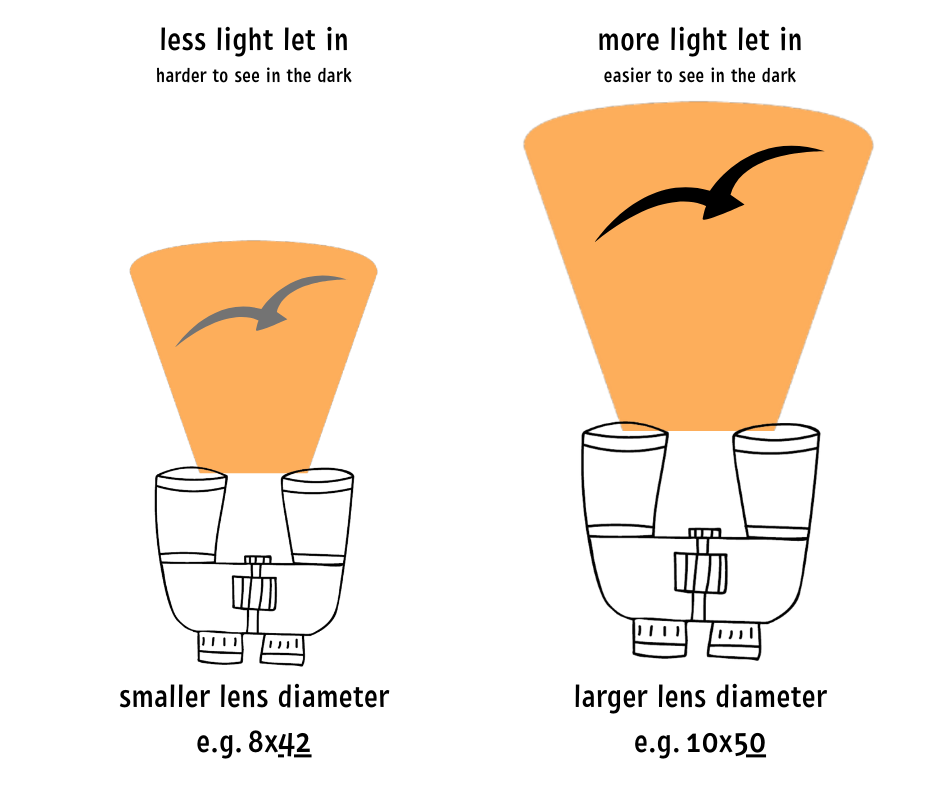How to buy binoculars
5 minute read
This How-to provides a list of what to look out for when buying a binoculars.
Magnification
What is it? Your binoculars ability to zoom in and magnify what you are seeing.
Magnification the first number in binocular specifications e.g. 8x42, 10x50
This number tells you how many times you can zoom in, compared to what you see with your naked eye.
A lower number (e.g. 8x42) means a lower magnification but a wider field of view. You will see more of the ‘scene’ (such as watching flying birds) but can’t zoom in as much, .
A higher number (e.g. 10x50) means a higher magnification but a narrower field of view. You will see less of the ‘scene’ but can zoom in more.
What to choose? Don’t worry! Anything over 8 magnification (8 x your natural eyesight) will help you be a better birdwatcher. Some birdwatchers like 8 magnification because the binoculars are more compact and light-weight. Other birdwatchers like 10 magnification (10 x your natural eyesight) because they want to zoom in more and are OK about holding heavier binoculars.
Objective lens diameter
What is it? How much light your binoculars can gather through the front of the lens in millimeters.
Objective lens diameter is the second in binocular specifications e.g. 8x42, 10x50
A lower number (e.g. 8x42) means that the diameter at the front of the lens is smaller. The image will be less bright and you will find it harder to see in darker conditions (e.g. dawn and dusk).
A higher number (e.g. 10x50) means that the diameter at the front of the lens is larger. The image will be more bright and you will find it a easier to see in darker conditions.
What to choose? Don’t stress! You can’t go wrong with any binoculars with over a 42mm objective lens diameter. Some birdwatchers like a 42mm diameter because the binoculars are more compact and light-weight. Other birdwatchers like 50mm diameter because they want to do more birdwatching at dusk and dawn, and are able to hold heavier binoculars.
Other things
Budget - Binoculars come in a wide price range and don’t need to break the bank. While fancy features are enticing, you can aim for a mid-range option that strikes a balance between quality and affordability.
Opt for comfort - Birdwatching involves spending lots of time outdoors. Look for binoculars with an ergonomic design, comfortable grip and adjustable eyecups that accommodate glasses if needed.
Waterproof and fogproof - Choose binoculars that are both waterproof and fogproof, especially if you plan to go birdwatching in various conditions.
Lens coating - Look for binoculars with terms like "fully multi-coated lenses" or "anti-reflective coatings" to ensure a clear and bright image.
Brand reputation - Established brands often offer reliable products. Look for brands like Canon, Celestron, Leica, Nikon, Swarovski and Zeiss.
Do a test
Following the advice above, your next step is to find a local binoculars shop and try on a few pairs. You will get to know whether you would like a heavier (and usually more expensive) pair of binoculars or if you would like to start with something more compact and lightweight.
Weekend Birder episodes
Weekend Birder podcast is here to help you buy and use binoculars.



